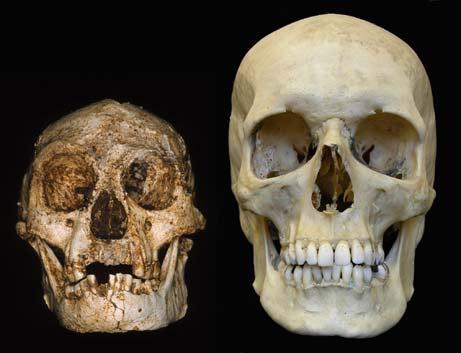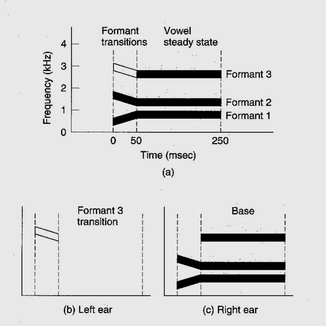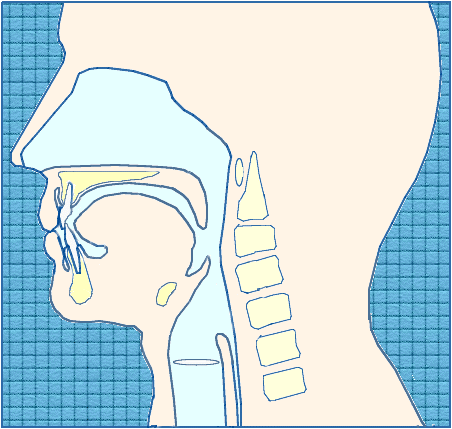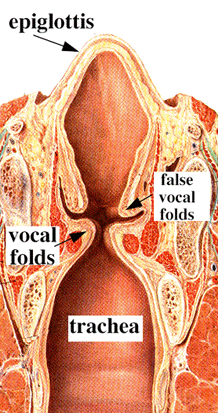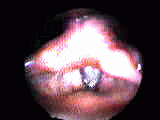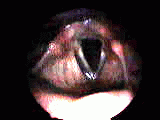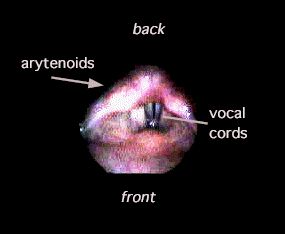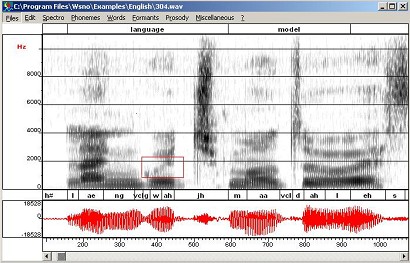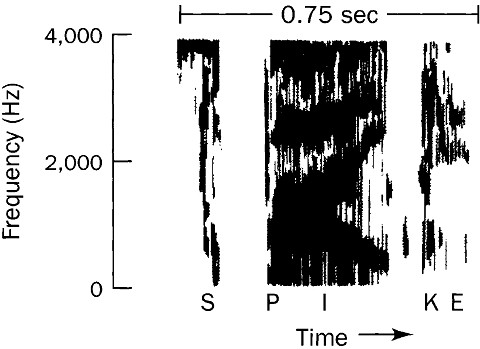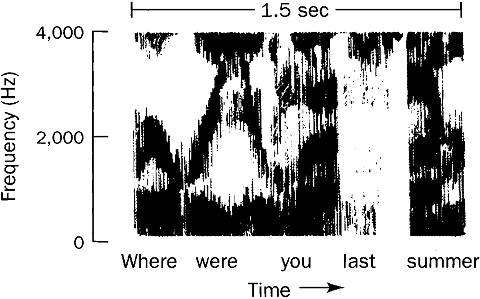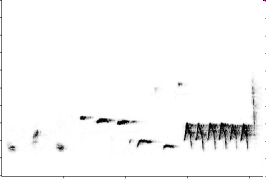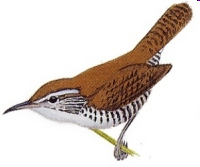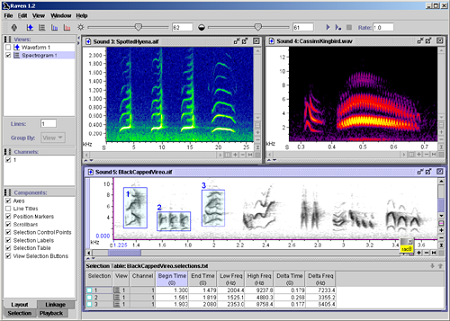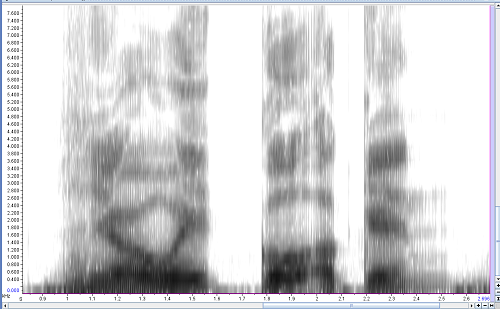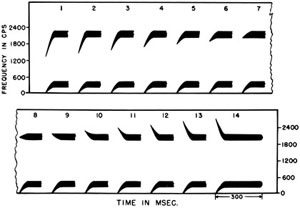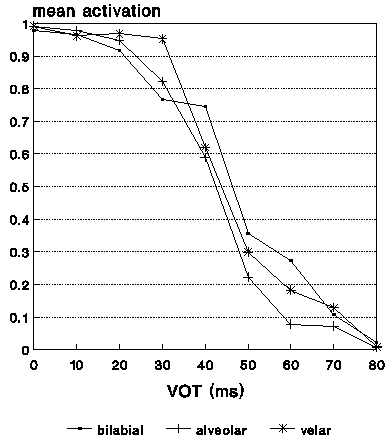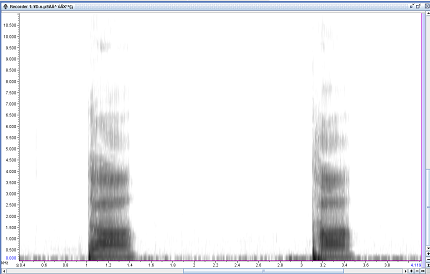第十三講:Speech Perception
出自KMU Wiki
(修訂版本間差異)
| 在2011年12月18日 (日) 00:01所做的修訂版本 (編輯) 98007013 (對話 | 貢獻) (→motor theory of speech perception) ←上一個 |
當前修訂版本 (2014年1月15日 (三) 18:31) (編輯) (撤銷) Woody (對話 | 貢獻) (→Infant speech perception) |
||
| (7個中途的修訂版本沒有顯示。) | |||
| 第1行: | 第1行: | ||
| - | + | ==何時開始?== | |
| *語言 | *語言 | ||
| **智人(Homo sapiens)之前 | **智人(Homo sapiens)之前 | ||
| 第5行: | 第5行: | ||
| *多久之前? | *多久之前? | ||
| **演化的想法 | **演化的想法 | ||
| - | |||
| *音樂 | *音樂 | ||
| **歌唱 | **歌唱 | ||
| 第15行: | 第14行: | ||
| [[Image:13.01.jpg]] | [[Image:13.01.jpg]] | ||
| - | + | ==語言特殊性== | |
| *語言是人特有的嗎? | *語言是人特有的嗎? | ||
| **語言的定義? | **語言的定義? | ||
| 第27行: | 第26行: | ||
| [[Image:13.02.jpg]] | [[Image:13.02.jpg]] | ||
| - | + | ==發聲器官== | |
| - | + | *參照第318頁 figure 13.1 | |
| *語音的產生是由肺呼出空氣,空氣經由聲帶(vocal cords)震動、經過不同發聲器官(articulators),包括軟顎(soft palate)、硬顎(hard palate)、舌頭(tongue)、牙齒(teeth)、嘴唇(lips)的加壓或阻斷,而產生不同的語音 | *語音的產生是由肺呼出空氣,空氣經由聲帶(vocal cords)震動、經過不同發聲器官(articulators),包括軟顎(soft palate)、硬顎(hard palate)、舌頭(tongue)、牙齒(teeth)、嘴唇(lips)的加壓或阻斷,而產生不同的語音 | ||
| - | + | ===發聲器官運動與聲音變化=== | |
| - | + | *參照第319頁 figure 13.3 | |
| ===呼吸與吞嚥=== | ===呼吸與吞嚥=== | ||
| 第51行: | 第50行: | ||
| *formants | *formants | ||
| - | + | *參照第320頁 figure 13.4 | |
| ===phonemes=== | ===phonemes=== | ||
| 第60行: | 第59行: | ||
| [http://ling.yale.edu/Ling120/Index.html DEMO"最近連不上(如果有人找到請告知)"] | [http://ling.yale.edu/Ling120/Index.html DEMO"最近連不上(如果有人找到請告知)"] | ||
| *有關鍵期 | *有關鍵期 | ||
| - | |||
| *子音/母音 | *子音/母音 | ||
| - | + | *參照第320頁 table 13.1 | |
| ====子音==== | ====子音==== | ||
| 第109行: | 第107行: | ||
| *formant / formant transition(共振峰/共振峰過渡) | *formant / formant transition(共振峰/共振峰過渡) | ||
| - | + | *參照第321頁 figure 13.5 | |
| - | + | ||
| *formant / formant transition(實際) | *formant / formant transition(實際) | ||
| - | + | *參照第322頁 figure 13.6 | |
| ===Formant transition=== | ===Formant transition=== | ||
| 第120行: | 第117行: | ||
| [[Image:13.20.jpg]] | [[Image:13.20.jpg]] | ||
| - | + | ==Speech categorization(語音分類)== | |
| *VOT | *VOT | ||
| - | + | ||
| + | *參照第323頁 figure 13.8 | ||
| ===Voice Onset Time=== | ===Voice Onset Time=== | ||
| - | + | *參照第323頁 figure 13.9 | |
| ===VOT實驗=== | ===VOT實驗=== | ||
| - | + | *參照第323頁 figure 13.10 | |
| ===Voice onset time=== | ===Voice onset time=== | ||
| 第142行: | 第140行: | ||
| [[Image:13.25.png]] | [[Image:13.25.png]] | ||
| - | + | ==Information Provided by Face== | |
| - | + | *參照第324頁 figure 13.11 | |
| *McGurk effect | *McGurk effect | ||
| 第160行: | 第158行: | ||
| *Speech Segmentation | *Speech Segmentation | ||
| - | + | *參照第326頁 figure 13.12 | |
| ===sound of the WORD=== | ===sound of the WORD=== | ||
| 第173行: | 第171行: | ||
| ===Saffran et al. (1996)=== | ===Saffran et al. (1996)=== | ||
| - | + | *參照第327頁 figure 13.13 | |
| ===top-down / bottom-up=== | ===top-down / bottom-up=== | ||
| - | + | *參照第328頁 figure 13.14 | |
| ===cortical location=== | ===cortical location=== | ||
| - | + | *參照第329頁 figure 13.15 | |
| ===duel-stream model=== | ===duel-stream model=== | ||
| - | + | *參照第329頁 figure 13.16 | |
| + | ===Reconstructed spectrogram=== | ||
| + | *參照第330頁 figure 13.17 | ||
| + | *Pasley et. al. (2012) | ||
| + | *speech sound VS reconstructed spectrogram | ||
| + | *參照第330頁 figure 13.18 | ||
| ===每日一字=== | ===每日一字=== | ||
| *卵怎麼注音? | *卵怎麼注音? | ||
| **ㄖㄨㄢˇorㄌㄨㄢˇ | **ㄖㄨㄢˇorㄌㄨㄢˇ | ||
| ***motor theory of speech recognition(語音辨識的運動理論) | ***motor theory of speech recognition(語音辨識的運動理論) | ||
| + | ===利用TMS實驗=== | ||
| + | *D'Ausilio et. al. (2012) | ||
| + | *參照第331頁 figure 13.19 | ||
| - | == | + | ==Infant speech perception== |
| - | + | *categorical perception | |
| - | + | *參照第332頁 figure 13.20 | |
| ===Think about=== | ===Think about=== | ||
| 第197行: | 第203行: | ||
| **Apple iPhone 4S siri | **Apple iPhone 4S siri | ||
| ***[http://www.youtube.com/watch?v=COLvS68ceQ4 官方廣告] | ***[http://www.youtube.com/watch?v=COLvS68ceQ4 官方廣告] | ||
| - | ***[http://www.youtube.com/watch?v= | + | ***[http://www.youtube.com/watch?v=Qh-kutOUmSs 日本人使用] |
| *語音?聲音?空間辨識 | *語音?聲音?空間辨識 | ||
| - | **sound spectrogram | + | **sound spectrogram [http://www.seeingwithsound.com/javoice.htm vOICe系統] |
| ***永 | ***永 | ||
| ***Obama | ***Obama | ||
| + | |||
| + | |||
| + | 返回[[知覺心理學]] | ||
當前修訂版本
目錄 |
[編輯] 何時開始?
- 語言
- 智人(Homo sapiens)之前
- 多久之前?
- 演化的想法
- 音樂
- 歌唱
- 樂器
[編輯] 人類演化
- 演化可能時程
[編輯] 語言特殊性
- 語言是人特有的嗎?
- 語言的定義?
- 創造性
- 可塑性
- 自發性
- .....
- 其他動物的溝通方法
- 語言的定義?
- duplex theory (雙重論) —Liberman(1982)
[編輯] 發聲器官
- 參照第318頁 figure 13.1
- 語音的產生是由肺呼出空氣,空氣經由聲帶(vocal cords)震動、經過不同發聲器官(articulators),包括軟顎(soft palate)、硬顎(hard palate)、舌頭(tongue)、牙齒(teeth)、嘴唇(lips)的加壓或阻斷,而產生不同的語音
[編輯] 發聲器官運動與聲音變化
- 參照第319頁 figure 13.3
[編輯] 呼吸與吞嚥
- 呼吸與吞嚥是不能兼顧的
- 吃飯時不要講話!
- 聲帶
[編輯] Sound spectrogram
- 音譜儀
- formants
- 參照第320頁 figure 13.4
[編輯] phonemes
- 音素(音位)
- 母音vowel
- 子音consonant
- 每一種語言不同
- 有關鍵期
- 子音/母音
- 參照第320頁 table 13.1
[編輯] 子音
- Articulation(發音)
- place of articulation (發音部位)
- Bilabial (雙唇)
- labio-dental(唇齒)
- Dental(齒)
- Alveolar(齒槽)
- .......place of articulation
- manner of articulation(發音方法)
- Stop(停止音)
- fricative(摩擦音)
- affricate(氣音)
- Nasals(鼻音)
- ......manner of articulation
- place of articulation (發音部位)
[編輯] Sound spectrogram(音譜儀)
- 畫出聲音
- 三個向度
- Software : Raven
[編輯] 語音的分析
- 聽覺系統
- (真實情況)
- 我唸的 Here we go again.
- formant / formant transition(共振峰/共振峰過渡)
- 參照第321頁 figure 13.5
- formant / formant transition(實際)
- 參照第322頁 figure 13.6
[編輯] Formant transition
- 不同子音
[編輯] Speech categorization(語音分類)
- VOT
- 參照第323頁 figure 13.8
[編輯] Voice Onset Time
- 參照第323頁 figure 13.9
[編輯] VOT實驗
- 參照第323頁 figure 13.10
[編輯] Voice onset time
以上請先閉眼來聽
- demo for VOT
- Bilabial negative
- Bilabial positive
[編輯] Voice onset time (實際)
- 我唸da ta
[編輯] Information Provided by Face
- 參照第324頁 figure 13.11
- McGurk effect
McGurk effect 請先閉眼來聽 接著再看著聽 WIKI
[編輯] Information from Sentence Context
- Perceiving word in sentence
- M*R* H*D * L*TTL* L*MB I*S FL**C* W*S WH*T* *S SN*W
- Mary had a little lamb, Its fleece was white as snow.
- M*R* H*D * L*TTL* L*MB I*S FL**C* W*S WH*T* *S SN*W
- technique of shadowing
- Speech Segmentation
- 參照第326頁 figure 13.12
[編輯] sound of the WORD
- transitional probabilities 轉移機率
- statistical learning
- Saffran et al. (1996)的實驗
- 利用infants
- nonsense word 2 minutes
- 如 bidaku, padoti, ...
- 後出現a. whole-word b. part-word
[編輯] Saffran et al. (1996)
- 參照第327頁 figure 13.13
[編輯] top-down / bottom-up
- 參照第328頁 figure 13.14
[編輯] cortical location
- 參照第329頁 figure 13.15
[編輯] duel-stream model
- 參照第329頁 figure 13.16
[編輯] Reconstructed spectrogram
- 參照第330頁 figure 13.17
- Pasley et. al. (2012)
- speech sound VS reconstructed spectrogram
- 參照第330頁 figure 13.18
[編輯] 每日一字
- 卵怎麼注音?
- ㄖㄨㄢˇorㄌㄨㄢˇ
- motor theory of speech recognition(語音辨識的運動理論)
- ㄖㄨㄢˇorㄌㄨㄢˇ
[編輯] 利用TMS實驗
- D'Ausilio et. al. (2012)
- 參照第331頁 figure 13.19
[編輯] Infant speech perception
- categorical perception
- 參照第332頁 figure 13.20
[編輯] Think about
- 語音?聲音?空間辨識
- sound spectrogram vOICe系統
- 永
- Obama
- sound spectrogram vOICe系統
返回知覺心理學
